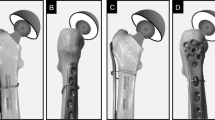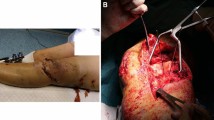Abstract
Purpose
Given the recent controversy in the literature and the alarming reports of early mechanical failure associated with the use of the Synthes 4.5 mm VA-LCP Curved Condylar Plate in acute distal femur fractures, the goal of our study was to examine the outcomes and mechanical failure rates of this implant in a larger patient population.
Methods
Patients 18 years of age and older who underwent plate fixation of their acute distal femoral fracture using the Synthes 4.5 mm VA-LCP Curved Condylar Plate were included in this retrospective study. The study data was collected through a retrospective chart review and review of the existing radiographic studies. Primary outcome measure was mechanical hardware failure while secondary outcome measures included nonunion, malunion, and medical and surgical complications.
Results
A total of 74 patients (77 fractures) were included in this study. The fractures were classified according to the OTA/AO classification as 33-A2 (n = 6), 33-A3 (n = 19), 33-C1 (n = 5), 33-C2 (n = 25), and 33-C3 (n = 22). Thirty-two out of 77 fractures presented as open fractures (41.6%). A mechanical failure was observed in 7 patients (9.1%). Twenty additional patients needed a re-operation of the surgical site including two nonunion repairs, one malunion repair, 15 staged treatments of traumatic segmental bone defects, and two soft tissue debridements.
Conclusions
In our experience, the Synthes 4.5 mm VA-LCP Curved Condylar Plate is a safe and effective implant with a relatively low mechanical failure rate.




Similar content being viewed by others
References
Davison BL (2003) Varus collapse of comminuted distal femur fractures after open reduction and internal fixation with a lateral condylar buttress plate. Am J Orthop 32:27–30
Frigg R, Appenzeller A, Christensen R, Frenk A, Gilbert S, Schavan R (2001) The development of the distal femur Less Invasive Stabilization System (LISS). Injury 32(Suppl 3):S24–S31
Haidukewych G, Sems SA, Huebner D, Horwitz D, Levy B (2007) Results of polyaxial locked-plate fixation of periarticular fractures of the knee. J Bone Joint Surg Am 89:614–620
Kim W, Song JH, Kim JJ (2015) Periprosthetic fractures of the distal femur following total knee arthroplasty: even very distal fractures can be successfully treated using internal fixation. Int Orthop 39:1951–1957
Kregor PJ, Stannard JA, Zlowodzki M, Cole PA (2004) Treatment of distal femur fractures using the less invasive stabilization system: surgical experience and early clinical results in 103 fractures. J Orthop Trauma (8):509–520
Li B, Gao P, Qiu G, Li T (2016) Locked plate versus retrograde intramedullary nail for periprosthetic femur fractures above total knee arthroplasty: a meta-analysis. Int Orthop 40:1689–1695
Özcan Ç, Sökücü S, Beng K, Çetinkaya E, Demir B, Kabukçuoğlu YS (2016) Prospective comparative study of two methods for fixation after distal femur corrective osteotomy for valgus deformity; retrograde intramedullary nailing versus less invasive stabilization system plating. Int Orthop 40:2121–2126
Schütz M, Müller M, Krettek C, Höntzsch D, Regazzoni P, Ganz R, Haas N (2001) Minimally invasive fracture stabilization of distal femoral fractures with the LISS: a prospective multicentre study. Results of a clinical study with special emphasis on difficult cases Injury 32(Suppl 3):S48–S54
Weight M, Collinge C (2004) Early results of the less invasive stabilization system for mechanically unstable fractures of the distal femur (AO/OTA types A2, A3, C2, and C3). J Orthop Trauma 18:503–508
Henderson CE, Lujan TJ, Kuhl LL, Bottlang M, Fitzpatrick DC, Marsh JL (2011) 2010 Mid-America Orthopaedic Association Physician in Training Award: healing complications are common after locked plating for distal femur fractures. Clin Orthop Relat Res 469:1757–1765
Kim SM, Yeom JW, Song HK, Hwang KT, Hwang JH, Yoo JH (2018) Lateral locked plating for distal femur fractures by low-energy trauma: what makes a difference in healing? Int Orthop doi. https://doi.org/10.1007/s00264-018-3881-3
Koso RE, Terhoeve C, Steen RG, Zura R (2018) Healing, nonunion, and re-operation after internal fixation of diaphyseal and distal femoral fractures: a systematic review and meta-analysis. Int Orthop doi. https://doi.org/10.1007/s00264-018-3864-4
Ricci WM, Streubel PN, Morshed S, Collinge CA, Nork SE, Gardner MJ (2014) Risk factors for failure of locked plate fixation of distal femur fractures: an analysis of 335 cases. J Orthop Trauma 28:83–89
Rodriguez EK, Zurakowski D, Herder L, Hall A, Walley KC, Weaver MJ, Appleton PT, Vrahas M (2016) Mechanical construct characteristics predisposing to non-union after locked lateral plating of distal femur fractures. J Orthop Trauma 30:403–408
Barei DP, Beingessner DM (2012) Open distal femur fractures treated with lateral locked implants: union, secondary bone grafting, and predictive parameters. Orthopedics 35:e843–e846
Rodriguez EK, Boulton C, Weaver MJ, Herder LM, Morgan JH, Chacko AT, Appleton PT, Zurakowski D, Vrahas MS (2014) Predictive factors of distal femoral fracture nonunion after lateral locked plating: a retrospective multicentre case-control study of 283 fractures. Injury 45:554–559
Erhardt JB, Vincenti M, Pressmar J, Kuelling FA, Spross C, Gebhard F, Roederer G (2014) Mid term results of distal femoral fractures treated with a polyaxial locking plate: a multi-centre study. Open Orthop J 8:34–40
Gwinner C, Märdian S, Dröge T, Schulze M, Raschke MJ, Stange R (2015) Bicortical screw fixation provides superior biomechanical stability but devastating failure modes in periprosthetic femur fracture care using locking plates. Int Orthop 39:1749–1755
Hanschen M, Aschenbrenner IM, Fehske K, Kirchhoff S, Keil L, Holzapfel BM, Winkler S, Fuechtmeier B, Neugebauer R, Luehrs S, Liener U, Biberthaler P (2014) Mono- versus polyaxial locking plates in distal femur fractures: a prospective randomized multicentre clinical trial. Int Orthop 38:857–863
Mäkinen TJ, Dhotar HS, Fichman SG, Gunton MJ, Woodside M, Safir O, Backstein D, Willett TL, Kuzyk PR (2015) Periprosthetic supracondylar femoral fractures following knee arthroplasty: a biomechanical comparison of four methods of fixation. Int Orthop 39:1737–1742
Otto RJ, Moed BR, Bledsoe JG (2009) Biomechanical comparison of polyaxial-type locking plates and a fixed-angle locking plate for internal fixation of distal femur fractures. J Orthop Trauma 23:645–652
Tank JC, Schneider PS, Davis E, Galpin M, Prasarn ML, Choo AM, Munz JW, Achor TS, Kellam JF, Gary JL (2016) Early mechanical failures of the Synthes variable angle locking distal femur plate. J Orthop Trauma 30:e7–e11
Marsh JL, Slongo TF, Agel J, Broderick JS, Creevey W, DeCoster TA, Prokuski L, Sirkin MS, Ziran B, Henley B, Audigé L (2007) Fracture and dislocation classification compendium - 2007: Orthopaedic Trauma Association classification, database and outcomes committee. J Orthop Trauma 21(10 Suppl):S1–S133
Pascarella R, Bettuzzi C, Bosco G, Leonetti D, Forte P, Amendola L (2014) Results in treatment of distal femur fractures using polyaxial locking plate. Strategies Trauma Limb Reconstr 9:13–18
Author information
Authors and Affiliations
Corresponding author
Rights and permissions
About this article
Cite this article
Dang, K.H., Armstrong, C.A., Karia, R.A. et al. Outcomes of distal femur fractures treated with the Synthes 4.5 mm VA-LCP Curved Condylar Plate. International Orthopaedics (SICOT) 43, 1709–1714 (2019). https://doi.org/10.1007/s00264-018-4177-3
Received:
Accepted:
Published:
Issue Date:
DOI: https://doi.org/10.1007/s00264-018-4177-3




